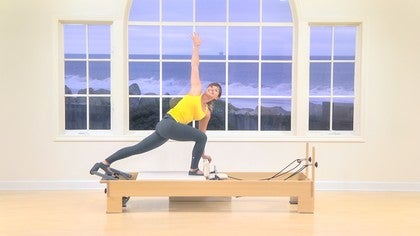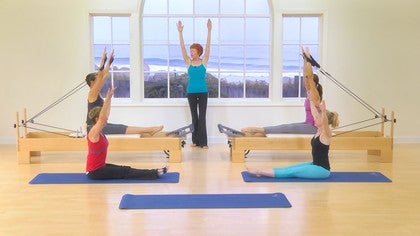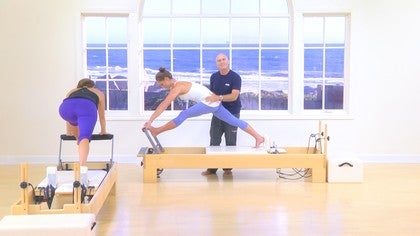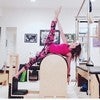Description
About This Video
Transcript
Read Full Transcript
Welcome to everyone. My names is Rael Isacowitz. I'm delighted to be here at Pilates Anytime and I thank Pilates Anytime for creating this forum of a meeting of the minds and thank you to my dear friend Meredith and Sara for being here and we're gonna go through a reformer session. The whole session will be on the reformer other than the first exercise. And we'll go through what we call the Basi Block System which is a systematic progression and methodology through a workout.
So if the two of you could start with a roll down. So, we're going to inhale and exhale, creating that beautiful alignment of the body Sara, so we'll just take a few breaths, inhaling and exhaling. Feel your feet well grounded. This moment in the session is very important. It sets the stage for the session.
It sets the tone for the session. It cleanses the mind and the body. Inhale and as you exhale roll down through the spine and inhale and exhale as you roll up. If you feel any pressure on your back, feel free to bend your knees and inhale and exhale as you gently roll through the spine, warming up the spine, gently stretching the back side of the body and exhale as you roll up. And inhale, this allows me time to check that alignment and exhale as you roll down to correct intricate alignment.
And it allows you the time to focus in on your body and exhale. Connect all the parts of your body. And one last one, inhale and exhale. As you roll down, feel the cascading of the spine. Remember that these hamstrings are engaged.
They provide support to the back of the leg, the back of the knee and as you roll up, you're stacking the spine upon the pelvis and thank you. If you could both set the springs at the setting that you do your footwork, please set your spring at the setting you do your footwork and if you could lie down on your side and place your feet on the bar. I'd like the headrest to be down. I actually prefer working with the headrest down during the foot work. If there's a reason it should be up, I understand that, but that gives us a very strong neutral alignment.
You're on your heels in this position. I want you to inhale and do a pelvic curl as you exhale and roll up. You feel those hamstrings engaging. Inhale and exhale. And I ask for the resistance that you do your footwork because this gives you support.
So the hamstrings aren't being overused where the spring is light. I tends to overuse the hamstrings. The hamstrings have a lot of support as you roll up. And inhale and exhale. As you roll down.
At the same time it's good to feel those hamstrings beginning to engage. We need those hamstrings during the foot work. Inhale and exhale as you roll up. Beautiful. Make sure that he pelvis is nice and square.
The work on both legs is even and roll down. Excellent. Bring the legs together and lift them into a tabletop position, simply circle arms around and hold onto the handles. If you don't have handles, holding onto the shoulder rest is absolutely fine and you take your legs over to the right to stretch the spine and get the rotators of the spine working, keeping the scapula nice and stable. Exhale back to center.
Inhale as you go over to the side. And exhale back to center. The handles aid us in keeping the stability. Inhale as you go over to your right. And exhale back to center.
Inhale to the left. Good Sara, keep those scapula well grounded. And inhale, keeping the knees together and try and elongate the back and give a bias to the abdominal muscles. Inhale as we go over and exhale back to center. Bring the hands to your knees and lift up.
We're going to do the double leg stretch. Now I know the shoulder rests are behind you, but that's good. It will keep you honest, it will keep you nice and high. As you reach the arms back you should feel those shoulder rests. You can actually press against them to get a little more lift.
And exhale and Sara found that, didn't you Sara? Inhale and exhale. It's a wonderful little cue for you. And inhale and exhale. This is the immaculate work.
A little wider with the arms as you come around, Meredith, beautiful. And inhale and exhale and inhale and exhale. Notice how far back their arms are going. I absolutely love that, that's very exciting to see. Hold it there and slowly down.
Give yourselves a little rest by pulling the knees to the chest and as the knees go back toward 90 degrees you lift up, single leg stretches. Hands on your right knee and stretch the left leg. Exhale, inhale to change exhale. And three and four and five and press on the knee, six, and seven, stay nice and high. Eight and nine and ten, hold it.
Hands behind the head. Lift up a little higher. And change legs and rotate. One and two, looking there and three, looking there, and four, yes, directly towards me. So notice how beautifully they're rotating.
Get that rotation and not lateral flexion. Keep that leg a little lower. The legs are just above the bar. It gives you that perfect indication that the leg is at a perfect height and da, and da, we started to that side, so we will finish on that side and hold it. Am I correct, did we finish on the right side?
Yes. Yes, lift up a little higher. A little higher. Come to center, hold it there, hold it there, hold it there. Five times we curl the legs up towards the chest and lift the pelvis off, one.
And down and two and down. And three and down. And lifting the knees up and down. And the pelvis curls and slowly down. Place the heels on the bar.
Arms down at your side and you're ready for the footwork from the heel and ten times. One, and two and three, on number ten we're gonna hold it up there. And four and five and six and seven, a little slower on the way down. Eight and nine and ten. Stay up there, stay up there, stay up there.
This is where I want you to feel the muscles. I want you to milk the muscles. Now slowly come down. It's too far Sara, slowly. Slow motion.
Change to the balls of the feet. And you exhale 10 times. One and, notice how the heels remain absolutely still. The heels are stable. Ball, five, keep the adductors working a little more.
Six. Seven. Eight. Nine. And 10, stay up there, stay up there.
That is your maximum plantar flexion. That is where the heels stay when you bend the knees and slowly, slowly, slowly, slowly, don't rush out there. Slowly and we reach it. Bring the heels together. The eccentric contraction is everything.
Don't forget it. And the small V position with the legs and exhale as you push and inhale. Exhale, beautiful work and exhale. Notice how they reach their full extension. I believe that's five.
And six. I still feel she's coming down a little far, so this is what I'm gonna do. And go and resist me, resist, yes. And out and resist, yes. And resist.
And up, stay there. Hold it, hold it and slowly down. Now that's an eccentric contraction. The eccentric gives it that sense of control. And that's what we need, yes.
That's a little too wide or a little too externally rotated. Beautiful, support you. And exhale as you push and inhale. And exhale and inhale. And exhale and inhale.
And exhale and inhale. Exhale, think of that stability, exhale. And we do 10 of these. Good. Have you ladies been counting your 10, that's nine and one more and 10, stay out there, hold it.
This gives you an opportunity to feel the length of the body and the limbs and slowly down to reacquaint yourselves with that eccentric contraction and same thing on the toes, the wide V position and exhale as you push. I love this. Yes. This is a position where you can feel the inside of the legs working, those adductors, the quadriceps, particularly the VMO, it tends to really engage that muscle. The heels are stable.
And thinking of the stability of the trunk and what number have we reached. Okay, one more and hold it up there. There was a dispute, so we erred on the side of more. Okay, always err on the side of more, I love you ladies, yes, couldn't ask for more and slowly. Lovely.
Now we go into our calves or calves for those that didn't understand calves. So, I want you to push out. Now it's not a matter of just lowering the heels, it's a matter of actively pulling into dorsiflexion, not just lowering, pulling into dorsiflexion to activate the tibialis anterior and up you go. Down. And up you go and down.
And up you go. Meredith, I want a little more hamstring engagement, thank you, up you go and down. And up you go. And reach. So you're always thinking of the back of the legs, yes, the hamstrings, the gastroc, but also the quadriceps.
Think of that knee being straight, supported and you've got those calves working. Pulling into dorsiflexion and pulling into dorsiflexion. Stay up there. Hold it and into our prances and go. Now remember with the prances, that the break pattern is two to exhale and two to inhale and one and two and da, da, da and long and long and that upper foot, the plantar flexion foot goes into full plantar flexion as that lower foot goes into dorsiflexion, both legs are working 100%, not one working less than the other.
Da and reach that top position and da and da and da and stay up there, long, long, long, long and slowly down. Because you've worked the calves so intensely, we're now gonna to the prehensile. A complicated position. Think to yourselves that you are in maximum dorsiflexion all the time. As the legs straighten and bend, as the knees straighten and bend, the heels are pushing under the ball.
You're in maximum dorsiflexion, so you're feel your tibialis anterior working a lot, the extensor digitorum and push out and bend. And this gives the feet, the calves such a wonderful stretch and push out. That's why it's so nice to do it just after all the calf work. And three. And four.
And. Five. And. Six. And.
Seven. And. Eight. And. Nine.
And 10, stay up there. Heels under, press those heels under, press those heels under. And slowly bend the knees. Lovely, excellent. What we do now is we just place the legs on the ball, because I know many of you alone you don't have someone to change the spring for you.
You will simply rest the legs on the bar, scoot down a little from the shoulder rest and then roll up, just reach forward, holding onto the bar, let the legs drape down. (laughing) Pull on to the bar and then straighten the legs as if you're in a teaser as you roll down and roll down and take the arms out to a T position. Nice, and then bend the legs and come forward. Reach, yes. I love it, holding onto the bar and lifting in the back and then straightening the legs and then control it as you roll down, keeping the arms nice and low.
Nice and low and then take them out into that T position. Just to, yes, just to the T and then drape the legs again and roll forward. Yes, look at that, holding onto that bar and get that beautiful. You know this position I love because it works the back, it works that rhomboid middle trapezius, lower trapezius, just look at that, look at that. Stay beautiful and straighten the legs.
That's exciting and roll down. Control it, control it Sara and out to the T position. One last one and roll forward. Yes, you did it bravo. And lifting up, change your springs to the single leg setting.
No, no, no, stay where you are, stay where you are. You don't have to get off your reformers. This is all staying on the reformer. Rolling down. So on the single leg setting, although this is individual, I suggest, I see people working a little bit light in my honest opinion.
I would suggest for the double leg that you work, for the women, I would say three and a half springs, meaning three full springs and maybe one additional half spring, light spring. For the men, I'm gonna say four and a half, meaning all the springs will be on and for single leg, take off that half spring or if you need to leave the half spring and take off a full spring. So you've got three springs on your rack, men, four springs on your rack. Now those who want to work a little heavier can. We're gonna take this leg under the bar and stretch it out, one of my favorite simple positions, because it gives that hip flexor a time to stretch out and provide the length, pushing of the heel and go.
Boom. And two. And three. And look how they keep their foot nice and still. So they're pivoting around the ankle.
And. And six. And seven. And eight. And nine.
And stay out there. So you feel that length, I love it. Anchor that side, that pushing side, that working side and come all the way down, let's change it. Other side. And push out, one.
And two. Three. Four. Hold it out there, hold it out there. And slowly down.
Changing to the toes, what we're going to do here is we're going to simply lift up and lower down. And lift up as you push out. So you push out with the leg, the other one lifts up and then comes down. And push out and down. And three, down, and four and down.
And five and down. And six and down. And seven, down. And eight down. And nine and down.
And 10, stay, stay, stay and slowly down. And changing legs. Think of the length of both legs as you push out and then both legs elongate to come down. And two. And three.
And four. And keep those heels very still. That heel of the pushing leg. And six. And seven.
Beautiful heels here Meredith. And eight. And nine. Think of the stability of that foot and 10. Hold it up there, holding it, holding it and slowly down.
Keep the alignment of the knees. Bend the leg under the bar, put it all the way straight, the other one all the way straight. You're going to do a roll up, but as you're rolling up, I want those legs to lift slightly off the platform. So you roll up, the legs lift slightly off the platform. Then they go down on the platform as you place your hands on the bar.
Lift up nice and tall and then roll down and arms go out to the side and roll up, lifting the leg slightly off the platform and this time we'll take them out to the side, so we'll get that opening at the top and the bottom. And then as they roll down again, lift them sightly off the platform so they're floating in the air, they're floating, just half, half an inch, or for those that work in centimeters, one centimeter off the platform and then as the shoulders are above the pelvis, you lift up opening out and rolling down. Keep those arms low Sara, keep the arms low and then opening up and one more. And forward. And up.
And put that hands on the bar, lifting the right leg just up and down. Lifting the right and you can press down onto the bar Sara. And lifting and lifting and oh, yeah, Sara, keep nice and upright here. And lifting. Other leg.
And press. And press. Use the upper body. Use the upper body. Use the abdominals and back for support, as we work those deep, deep, deep hip flexors.
Are they about even on both legs. Okay, now I want you to imagine it. I want you all to imagine it. You don't have to do it yet, but imagine it, that both legs lift off. They may or they may not, but imagine it.
And press, lift and two. And they're lifting magically. It was your imagination, but they lifted. Three and four. And five.
Change your spring, meaning for abdominal work and hip work I suggest one heavy spring, one light spring. For the men, two full springs and we now simply again roll down. Bend your knees, take your straps, I'm sorry, don't put your feet in the straps, put your hands in the straps. Okay. Lifting the legs into tabletop position, I want some tension in the spring already, some tension in the spring, elbows straight Sara.
Elbows straight. There must be some tension in the springs. Arms exactly opposite the shoulders, parallel to each other. As you lift up, the legs go straight up to the ceiling. Now you're gonna start your hundred beating and this leg is gonna go under the bar.
So it's gonna start there. So you exhale two, three, four, five, change. Inhale, two, three, four five. And exhale two, three, four, five. And inhale.
Like a bicycle. Exhale two, three, four, five and don't rush. It's got to have a calm about it Sara. Da, da, da, da, da, da, da, da. Lop, ba, ba, ba, da, da, da, da, da.
Rop ba, ba, ba, ba, da, da, da. And take both legs up to the ceiling. Tabletop position and take the arms up. Lovely, Sara, Sara, you're still there, still there, still there, don't get too excited. There we go.
Now we do an exercise we call a combination. It's a combination between the coordination and the abdominal openings. So you push out, exhale. Exhale, turn out the legs and arms. Inhale, go wide.
Exhale, come together. Parallel position, inhale you go down. And exhale as you come up. Turn out, inhale. Arms a little higher.
The arms must be parallel to the floor. Exhale as you some in and inhale as you come up. And exhale. I love the way you come nice and high Meredith, turn out. Inhale.
And exhale, notice Meredith's arms just go to the shoulder line, inhale, come up and exhale. Those arms could have been a bit higher there Meredith. Inhale, rotate, don't drop the arms too low Sara. There, hold that position, hold that position everyone, hold that position. Feel the power, feel the power.
Lift a little bit higher. Lift a little bit higher. You can hold it a little bit higher. Exhale. Hold it there.
Parallel position and feet in straps. Okay. Okay. Straightening the legs and pointing the feet. And we're gonna do five circles, so we go down and around and two.
And around. And three. And around. And four. Think of the eccentric contraction Sara.
Five, that's what gives it the flow, other direction. And one. And around. Think of your adductors working, this is all about inner thigh. This is all about pelvic stability, pelvic lumbar stability.
Two. And. Three. And. Four.
Notice how deep their work is, five. Hold it there at five. Bend the knees into the frog position. We do what we call the extended frog. You push from that frog position, holding dorsiflexion.
Open out to the side nice and wide, to the line of that hip joint if you can. Hold the tension in the spring as you simply bend the knees and bring the feet across. Don't bring the heels down, bring them directly across and push out. And two. A little more dorsiflexion.
And bending the knees, that's what you see as she brings them directly across and then push. And three. And holding the tension, holding the tension Sara. And let's do one more so we'll do four. Of course if you want to add a few more later on that's fine by me.
And we reverse it. From that frog, we now go outwards from the frog. And keep slight bending in the knees, slight flexion in the knee. You will feel the adductors working more and bend. And now reaching out to the side, the carriage stays still as you reach to the side.
Keep slight flexion of the knee to keep those hamstrings engaged. And bend. Is this number four. And reaching out, maybe that's number three, so we'll do another one to be absolutely sure, a little bit of dorsiflexion Sara. And bending.
And reaching out, hold it, hold it, hold it, hold it, enjoy that stretch, enjoy it. Bending inwards. I'm sorry, bring the legs straight. Straight together, together, together and now bend. If your headrests are up, please put your headrest down.
Our headrests have been down all the time. I prefer that open position. We're going into the short spine. Now I want you to watch this short spine as we go out. We point the feet.
We take the legs over, but the pelvis is staying down as far as possible, it will come up. But you try to keep it down until the carriage reaches the stopper. Roll up, exhale. And bend the knees. And exhale, you drop the feet opposite the face, but you drop the spine, roll the spine down.
When it cannot go any further, flex the feet, take the sacrum down and bring the legs across, not bending the knees, but extending the hips and go. Two. And all he way over. And rolling up. And bending.
And rolling down. And she flexes her feet, she extend the hips, brings that sacrum across and pushing out. All the way across. And rolling up. And bending.
Beautiful position to have. Notice how her back extends so working, supporting her trunk as she goes down, flexing the feet and boom that sacrum comes across, it anchors itself and that's where you pause. And then push out one last time. You get this beautiful hamstring stretch here. She brings the carriage to the stopper, so she has to use her own muscles to get up, not the springs.
And then bend. Look how nice and lifted she is here. And then rolls the pelvis down, the spine down. Cannot go any further. She gets the sacrum down and then pause.
If you could take one strap off and put your foot on the bar and then take the other strap off. Bring the carriage in and slowly, slowly roll off. You're doing amazing work, everyone's doing amazing work. We now put one full spring on. You can decide on the heavier side is easier.
We're doing a stretch. Lighter side is more difficult, but not more than one spring, thank you. If we can do what we call the full lunge. So we step onto the carriage. We anchor the right foot against the shoulder rest.
Now you're nice and stable. You're in control of the reformer. Put the other foot on the bar. You're in control at all times. At this point the knee is directly above the ankle.
You can just hold lightly. It's lovely just to hold lightly. And if you can, I would like you to try and take a balance in this position. This engages the hamstrings, you feel the hamstrings engaged. You feel the power of holding that position.
Think nice and low and that's where you stay. Put the hands back on the bar. Now the pelvis travels along the same line as you push out. It doesn't go up, and it doesn't got down. It stays on that same line.
Sara, you could sink just a little bit, that's perfect. In this position you're trying to use the back extensors, back extensors, back extensors, anterior tilt to the pelvis and bend the front knee. Now lift that chest up a little more. Don't come any further forward than the knee above the ankle. Gaze forward Sara, there, present yourself to the world.
Lovely. Now, keeping the pelvis on the same line, you push out. Not down, not up, Sara, you came up a little. There we go. But don't sink down.
Here you bias the pelvis towards and anterior tilt. When you're in the hip flexor stretch, you're biased towards a posterior tilt. Here the back extensors are engaged. Oh, look at that back. That's a back that I envy, I do, I do.
A little straighter with that leg. Yes. Take the chin down slightly. Okay, bring it back in. Not much fuss, you keep that leg there.
Join the leg on he bar to the shoulder rest so you're in that plank position. Powerful position. Show me it's powerful. Come back just a little bit Sara. Give me three pushups.
Wide? Wide, wide, push ups, triceps, I mean pec pushups. And two, keep those scats, keep those scats Meredith. That's what I'm looking for, that's a pushup. Push the other leg up, let's go.
I'll help you, there we go. It's tiring, I'll admit, this is tiring, this is tiring work. Okay, let's find our balance. Let's find our balance. Oh, look at the elegance.
Meredith, you could just sink just a little bit. And I want you to relax, yes, there we go. There we go. Arms a little wider Sara. Put the arms down, sink a little bit.
Here your posterior tilt. As you transition to the hamstring, you're going to an anterior tilt of the pelvis, pelvis nice and square, keep it square, keep it square. Try and feel that the stretching leg is pulling back slightly. Ah, so you maximize that hamstring stretch. And then bend.
Now you go a little posterior. Lift your chest up Sara. Present yourself to the world. And stretch back. Okay.
And bring it in. Join back into that plank position. We go push back as if you're doing a long stretch and into your up stretch. We do what we call up stretch two. So we've got this beautiful pyramid position, beautiful up stretched position, keep the flow, that's what's so beautiful as it goes from one to the next.
Arms stay absolutely still as you drop the pelvis down. Inhale and exhale as you lift up. And inhale as you go down. And exhale as you lift up. And inhale as you go down.
And exhale as you go up. And inhale as you go down. Notice how still they're arms are and exhale as you go up, transitioning into an elephant. We put the feet flat, we're gonna start with five basic elephants. So we like the back flat here to counter the tendency to round up.
And we inhale back, exhale forward. Notice that all the movement must come from the hip joint. There's no movement in the trunk, it's just the hip joint is flexing and then opening out. And exhale and one more, exhale and in. Transfer the weight towards your right arm.
The left arm goes to the center of the bar. Take that left leg out to the side, far out to the side, far out to the side. Now lift it up into your arabesque and we're going to do the arabesque with a square pelvis, but you can turn the leg out and away you go. And exhale, one and two. And three.
And four. We're gonna do five. And five. Now take that leg wide out to the side Sara and keep the height, keep the height Meri, Meri, keep that height, keep that height, keep the shoulders square, keep the height, keep the height, flex the foot and put it down. Good.
Transfer the weight to the other side. Notice we stayed all the time on the same spring. We didn't have to change our spring. Take the leg out to the side. And then Meri we transfer it to the arabesque.
Now we're keeping that pelvis, we're not opening the pelvis. I realize the open pelvis will give you more height, but we're working purely on those hip extensors and away you go. And one, back extensors are important here and two. And three. And four.
And five. Hold it there. Now take that leg out to the side, wide and high, wide and high, wide and high, Sara, Sara, lifting that leg. All of you lift your legs out to the side, a little higher, lifting those legs a little higher. Imagine my hand on your foot.
Now lift your foot off my hand, boom. Flex the foot and put it down. Same spring, I'm not changing the spring. Arms kneeling, facing that way. Facing the shoulder rests.
You're amazing ladies, you're amazing. Holding onto the straps. Now because we want a slightly shorter strap here, but we don't want to fiddle with the length, we simply hold above the actual straps. We're holding on the rope or leather strap, whatever you have. So let's start with chest expansion.
Straight arms, it only goes about 15 degrees in front of you, 20 degrees and pull. And inhale forward. And two. And three. And four.
And five. Yes. Oh, you're good. You're good. Look at how straight she is.
There's no flexion in that hip joint. Watch that you don't flex the hip joint even biased slightly posterior tilt. One more, one more, everyone, everyone, hold it. Hold it. Think of how proud you are lifting that sternum.
Take the arms forward. We're going to do a difficult thing now. I'm already expressing it's difficult. What you're gonna do is thigh stretch on a light spring, but we don't have to Go low, rounding up into posterior tilt. You reach back.
You don't have to go low, but hold that exact position. Inhale and exhale as you lift up. And then back to neutral. And exhale as you posterior tilt and go back. You don't have to go too far, but keep that position true.
Inhale and exhale as you lift up, very nice Sara. A little slower as you come up. And inhale back to neutral. And exhale. Yes, look at you, look at that, look at that, now keep it true.
Inhale and exhale, pull in abs. Are you with me. (laughing) And lift up. We had a little rebellion there. We'll do one more for Sara.
And inhale. And exhale. And it's tough, I know it's tough. Hold yourself together, beautifully integrated here. Look at that and exhale.
And lift up. Oh, gorgeous, turn around. Okay. Here will go to a half spring for the ladies. For the men one full spring, let's go.
Taking the straps, feet up against the shoulder rests. Very important to think of opening that hip joint, so you can either be neutral or slightly biased towards posterior tilt and exhale up. And around. Oh, seldom do I see such gorgeous work and exhale and inhale. And exhale.
You'll notice how their scapulae just float, accommodating for the movement of the humerus. It's beautiful, scapula humeral rhythm. Watch that you don't go behind the shoulder Meredith. And exhale. Do we have a count right now, no.
I think we're at about five and six. And at this point we're going to reverse direction. We did six and exhale. You could of course take it up to 10, but we're going to do six in each direction. (breathing) And notice how the arms go up and at the top there's a rotation as they rotate and come down, was that six, five and then one more.
And down. This is the important one and this is the tricep. What many people do is bring the arms forward because you have more leverage, mechanical advantage. I want those arms to go directly up without hyperextension, keep those hands just behind the head Meredith, so can you lower the hands any lower. So you're trying, so you're trying to take behind the head, yes.
So you take the hands behind. Feel your head as you go straight up. This demands tremendous abdominal work. Tremendous, keep the elbows a little wider and pushing up, but not back. So you're almost going back and straight up, yes, that's it.
Oh, gorgeous, I felt it straightaway. And up. And back. And one more. Elbows wide.
I love that, because elbows went wide and you pulled back your center. And down. Now we add one full spring. I know for the men you are now on two springs, the ladies on one and a half springs. We the biceps, one and two.
And notice how the elbows stay back. The upper arm does not move, just the lower arm moves. And pull. And three. I want a little more bend.
I want a little more bend Sara, so it touches there, yes. And. Five. (laughing) Six. And straighten the arms.
If we did an extra one, forgive me, that's perfect. And hop off. Okay, so now what we're going to do ladies, we're going to do a wonderful exercise. It's an oblique arch. You put one leg on that shoulder rest, that front shoulder rest.
Very elegantly you lift yourself up, you go out to the there. You come up into an arc. You go back out and you come back in. So you've got these lateral muscles working all the time and you come up into that arc and out and in and then very elegantly step off. One spring.
Let's go. We will do three beautiful ones on each side. So you're on your one arm. You put your top leg in front on a slight angle. This is the critical part for me.
As you get up, it's very slow and up. Yes. And bring the carriage all the way in and push out. And over. Look down at your arm.
You feel that arcing of the body and out. And now in. And two. And over. Looking down, looking down, lifting up, lifting up, everyone, bring it to the stopper, to the stopper.
And out. And in. And three. And over, over, over, over, over, up, up, up. I know you can all lift your pelvises a little higher.
And then out. And then in. And very elegantly you step off. Bravo. Other side.
We love the fact that we have two sides because on the second side we perfect it. Ready. Up. And reaching out. And arc.
Go, go, and out. And in. And out. Find that line, find that line, there we go. And over, over, over, over, Sara, are you lifting that pelvis, are you lifting the pelvis, is everyone lifting the pelvis.
And up. And in, yes. And one more. And out. And over.
And out. And in, in, in, in, in, in, in. And elegantly step off. If you could grab the long box, everyone grab their long boxes and put them on. You stay on the same spring and I don't mind you leaving your foot bar up.
I think it's good because it keeps your legs in the right position. We do what we call pulling straps three. I know it's not from the classic repertoire. You take the rope and you hold it underneath. You hold the the other one underneath.
You reach your arms forward. You pull back to there. You take the arms nice and high as you go over and then you go down. You reach back. You keep the height of the body.
You're still high and then you go down. Lovely, we'll have five of those and then I'm sorry right at the end from here, you'll lift yourselves up into a rest position. (clapping) Let's go on. So you're still on one spring. We haven't fapped around with the springs, keep it to a minimum and the straps go on the outside.
Palms facing upward, strap will be on the outside of the hand. Reaching the arms forward, Sara, you want a little bit of tension in that rope. Yes, we do, we do, we do, we want a little tension. And arms nice and high in the air Meredith and pull back. Keep the height of the body.
Take your arms around that, keep your backs up as the arms go around, only then do you lower the body and number two, take the arms around, I love that work, I love that work. I love this work, I love this work. And then down. And number three. And coming around, keep the arms high as they come around.
And number four. Sara, a little bit of height, a little bit of height Sara. Keep the height Sara, keep the height now. And then number five. And hold it there, hold it there everyone, hold it there, hold it there, hold it there, you're flying, you're soaring, you're soaring.
Sara, you're soaring. And take the arms around. Keep the height, keep the height everyone, keep the height and slowly down. Lower the straps to the floor, put your hands on the side of the box and gently push yourselves into a rest position. And give yourselves that well deserved rest.
You can actually let your arms hang forward Sara. Just there. There we go. Oh, yes. And if we could slowly get off the boxes and we finish the way we began so that we round off the session with those same roll downs.
Three roll downs. And inhaling. And exhale as you roll down. But here we'll bend the knees. Bend the knees nice and deep to give your back a chance to relax and exhale as you roll up.
And inhale. And exhale as you roll down. Bend the knees. And inhale and exhale as you roll up. And inhale.
And exhale as you roll down. Inhale. And exhale as you roll up. And stand for a moment, taking in the session, feeling that elongation of the body, feeling the stability, the calm, within your bodies. And thank you all very much.
The Teacher's Corner: Teaching Tools
Comments

Thank you Rael and PA!
And the transitions with spring changes were very helpful...
Thank you! :))
You need to be a subscriber to post a comment.
Please Log In or Create an Account to start your free trial.






























































